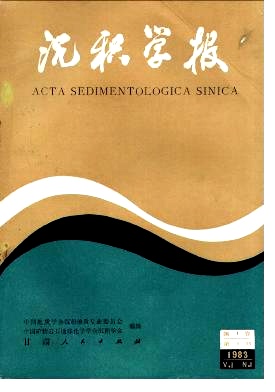THE GRAIN-SIZE FEATURES OF SEDIMENTS OF FUXIAN LAKE
- Received Date: 1982-05-10
- Publish Date: 1983-03-10
Abstract: Fuxian Lake is situated in the east of Yunnan Plateau. It is a lake of thegraben or intermontane type with fault blocks and scarps prevailing in its neighbour-hood, Its area covers 211 km2, and its maximum depth reaches 155 m with itsmean 89 m. Only minor rivulets run into the lake. The slopes of the lakeshore zone are,generally, rather abrupt, Floods containing a large amount of detritus swiftly flowinto the lake in rainy season. Its deposit characterizes lake basin sediment of grab-en type. On the plane, the deposits are distributed from the highenergy zone oflake-shore to the low-enery zone of deep-lake and their grain size is from coarse tofine, Both the belts of lakeshore gravel and shallow-lake sand-silt are comparativelynarrow, The water of sand-silt belt is generally deep up to 10-20 m, and the centralpart of the lake with muddy sediments covers 85% of the whole lacustrine area, The frequency curve of lakeshore deposits is of polykurtosis, Its grain size ran-ge is very wide, aФ-about 2.5, SK> 0;the cumulative curve presents an irregulararc, deposits mainly concentrate on the coarse end of the curve; traction popula-tion shows dominant in both log-probability plot and C/M diagram, which indicatescoarser grains and poor sorting, The frequency curves of shallow-lake deposits are strongly bimodal and the mainpeak of grain size concentrates on 3-5Ф, it shows that the deposits are mainly ma-de of silt and sand which contain mud, aФ-2 to3 ,skewaess being positives the pro-bability plot reflects that the deposits move in the way of saltation and suspensionor hypersaltatioas in the C/M pattern the range of grain size is wider, which indi-Gates the great differentiation of sorting, The kurtosis of the deep-lake deposits has a single peak, the grains are coarser than4Ф, and their main peak concentrates on 8一9小.It illustrates that all the depositsconsist of suspension population二ith QФof 1.5 to 2.0 and ske wness being negativeprobability plot has three log-normal segments, which represent coarse-silt, fine-si-It and clap respectively. The position of their junction correspondingly shifts towa-rds fine size with the increasing depth of watery the C/M diagram corresponds to the sedimentary area of suspension of the deep-sea, The turbidite deposits in the northern deep-lake are deposits of density flov-striggered by slumping and moving downslope, the grain size is coarser than that ofother deep-lake sediments, The vertical section of turbidite deposits is interbedding of sand,'mud with flyschfeature.The monocy-clic bed from the lower to the upper is moderate fine sand contain-ing gravel, silt-sand and clay in turn, w hick reflects the feature of graded bedding, The cyclic bottom is obviously- separated from underlying clay bed, The kurtos-is of the turbidite deposits is not obwious, and the grain sire range is v-ider infrequency cvarve; the probability plot in a straight line has a lo",c slope, indicatingpoor sorting; the position of points on Ci'\I diagram corresponds to the grabed su-speusion deposits, C/M pattern in long belt shape is parallel to C=M straight line. In other deep-lake areas, the sediment sections shoR isotropic clan, In this article the grain size data on 260 samplesare adopted. These samples were collected from the bottom of the lake, the core and partly from the lakeshore,among them the coarse ones are analyzed with sieve analysis and those fine-grainedones of 4.38Фare determined by automatic particle size distribution determinationappartus(Type RS-11)after being given separation treatment with supersonic wa-ve. mloreover, statistical parameters should be made to the grain size data with mo-went measure.
| Citation: | Gong Chi, Zhang Liren. THE GRAIN-SIZE FEATURES OF SEDIMENTS OF FUXIAN LAKE[J]. Acta Sedimentologica Sinica, 1983, 1(1): 50-62. |






 DownLoad:
DownLoad: